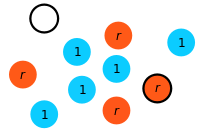Moran process: Difference between revisions
mNo edit summary |
No edit summary |
||
| Line 18: | Line 18: | ||
==Fixation probability== | ==Fixation probability== | ||
In unstructured populations the state of the population is fully determined by the number of mutants | In unstructured populations the state of the population is fully determined by the number of mutants | ||
\begin{align} | \begin{align} | ||
\qquad T_i^+ &= \frac{i\cdot r}{i\cdot r+(N-i)}\cdot\frac{N-i}N\ | |||
\qquad T_i^- &= \frac{N-i}{i\cdot r+(N-i)}\cdot\frac iN . | |||
\end{align} | \end{align} | ||
The first factor of \( | The first factor of \(T_i^+\) (\(T_i^-\)) indicates the probability that a mutant (resident) is chosen for reproduction and the second factor denotes the probability that the offspring replaces a resident (mutant). Note that the ratio of the transition probabilities \(T_i^+/T_i^- = r\) is independent of the number of mutants in the population. This leads to a simple recursive formula for the fixation probability \(\rho_i\) of the mutant in a population with | ||
\begin{align} | \begin{align} | ||
\label{eq:recursive} | \label{eq:recursive} | ||
\ | \qquad\rho_i = \frac r{1+r}\ \rho_{i-1}+\frac 1{1+r}\ \rho_{i+1}.\tag{1} | ||
\end{align} | \end{align} | ||
Thus, the dynamics corresponds to a biased random walk with absorbing boundaries. Eq. | Thus, the dynamics corresponds to a biased random walk with absorbing boundaries. Eq. | ||
\ | \begin{align} | ||
\rho_1 = \frac{\displaystyle 1-\frac1r}{\displaystyle 1-\frac1{r^N}}. | \label{eq:rho1} | ||
\ | \qquad\rho_1 = \frac{\displaystyle 1-\frac1r}{\displaystyle 1-\frac1{r^N}}.\tag{2} | ||
\end{align} | |||
Note that Eq. | |||
In the limit of infinite populations, | |||
\begin{align} | |||
\label{eq:rho1inf} | |||
\qquad\rho_1 = 1-\frac1r, | |||
\end{align} | |||
while the fixation probability of disadvantageous mutants, | |||
Celebrated results by the population geneticists [[#References|Maruyama (1970)]] and [[#References|Slatkin (1981)]] conjecture that fixation probabilities are unaffected by population structures, see [[Spatial Moran process]]. Indeed this turns out to be true for a large class of population structures, the [[Moran graphs]] but not in general. Instead, some population structures exhibit the intriguing properties that they act as [[Evolutionary amplifiers]], which amplify selection and suppress random drift such that beneficial mutants have a higher chance to fixate as compared to the original Moran process, or as [[Evolutionary suppressors]], which suppress selection and enhance random drift such that beneficial mutants have a lower chance to fixate, again compared to the original Moran process. | Celebrated results by the population geneticists [[#References|Maruyama (1970)]] and [[#References|Slatkin (1981)]] conjecture that fixation probabilities are unaffected by population structures, see [[Spatial Moran process]]. Indeed this turns out to be true for a large class of population structures, the [[Moran graphs]] but not in general. Instead, some population structures exhibit the intriguing properties that they act as [[Evolutionary amplifiers]], which amplify selection and suppress random drift such that beneficial mutants have a higher chance to fixate as compared to the original Moran process, or as [[Evolutionary suppressors]], which suppress selection and enhance random drift such that beneficial mutants have a lower chance to fixate, again compared to the original Moran process. | ||
Latest revision as of 22:47, 12 October 2023
The Moran process was named after its inventor, the geneticist P. A. P. Moran, who proposed in 1962 this stochastic process to model evolution in a finite, unstructured (well-mixed) population of constant size
Evolutionary dynamics
In the simplest case, the population is composed of residents (blue) and mutants (orange):

Setup: The state of the population is given by the number of residents (blue, fitness

Step 1: At each time step a focal individual is chosen for reproduction with a probability proportional to its fitness (here, a mutant is selected for reproduction).

Step 2: A randomly chosen individual is eliminated (here, a resident is selected for death).

Step 3: The offspring replaces the eliminated individual.
This process is repeated until either one of the two absorbing states is reached: a homogeneous state of either all residents (mutant went extinct) or all mutants (resident displaced). No other stable equilibrium state is possible. Whenever an absorbing state is reached, mutants (residents) are said to have reached fixation. The corresponding fixation probability and fixation time are important markers to characterize the evolutionary process. The Moran process represents a specific balance between selection and drift: advantageous mutations have a certain chance - but no guarantee - of fixation, whereas disadvantageous mutants are likely - but again, no guarantee - to become extinct.
Fixation probability
In unstructured populations the state of the population is fully determined by the number of mutants
In the limit of infinite populations,
Celebrated results by the population geneticists Maruyama (1970) and Slatkin (1981) conjecture that fixation probabilities are unaffected by population structures, see Spatial Moran process. Indeed this turns out to be true for a large class of population structures, the Moran graphs but not in general. Instead, some population structures exhibit the intriguing properties that they act as Evolutionary amplifiers, which amplify selection and suppress random drift such that beneficial mutants have a higher chance to fixate as compared to the original Moran process, or as Evolutionary suppressors, which suppress selection and enhance random drift such that beneficial mutants have a lower chance to fixate, again compared to the original Moran process.
References
- Moran, P. A. P. (1962) Random processes in genetics Proc. Cambridge Phil. Soc. 54 60-71.
- Maruyama, T. (1974) A Simple Proof that Certain Quantities are Independent of the Geographical Structure of Population Theor. Pop. Biol. 5 148-154.
- Slatkin, M. (1981) Fixation probabilities and fixation times in a subdivided population Evolution 35 477-488.
